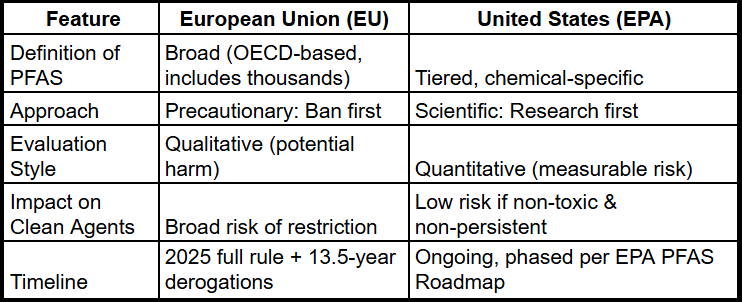Europe vs. U.S.: How PFAS Regulations Differ, and Why It Matters for Fire Protection
PFAS regulations are evolving fast—and the stakes for the fire protection industry are high. As clean agent fire suppression systems fall under increased scrutiny, understanding the difference between U.S. and European regulatory approaches to PFAS can mean the difference between compliance and confusion, continuity and costly disruption.
At Polits Strategies, we help companies navigate the complexities of PFAS-related fire protection policy. Here’s what you need to know.
What Are PFAS, and Why Are They Regulated?
PFAS (Per- and Polyfluoroalkyl Substances) are a broad group of synthetic chemicals used in everything from non-stick cookware and textiles to firefighting foams and clean agent fire suppression systems. Some PFAS are toxic, persistent in the environment, and bioaccumulative—posing serious health and ecological risks.
But here’s the key: not all PFAS are the same.
However, many regulatory efforts treat them as if they are.
Europe’s PFAS Ban: The Precautionary Principle in Action
The European Union (EU) is pursuing an aggressive regulatory strategy under the precautionary principle. Using the OECD’s broad definition of PFAS, the EU is proposing a near-total ban on thousands of chemicals—up to 20,000 substances—regardless of their individual risk profiles.
The message is: “If there’s even a chance these chemicals are dangerous, we should eliminate them now.”
This approach is broad and fast-moving, especially in high population density regions where PFAS contamination may pose amplified health risks.
The U.S. EPA Approach: Science-Based, Data-Driven PFAS Policy
In contrast, the U.S. Environmental Protection Agency (EPA) is taking a targeted, science-first approach to PFAS regulation. Rather than banning all PFAS, the EPA evaluates substances based on:
Toxicity and environmental persistence
Exposure pathways (air, water, soil)
Real-world data and quantitative analysis
Polluter accountability and remediation priorities
This granular, category-based method allows the EPA to protect public health while still enabling the use of safe, non-toxic clean agents in fire protection.
Why Fire Protection Professionals Must Pay Attention
If your company relies on clean agent fire suppression systems like FK-5-1-12 (Novec 1230), FM-200, or others, these regulatory differences matter—a lot.
These agents technically fall under the PFAS umbrella, but they are not bioaccumulative, not toxic, and not environmentally persistent.
However, in an overreaching regulatory climate, they risk being banned alongside truly hazardous PFAS.
We acknowledge that the issue of a breakdown product of halogenated clean agents (TFA) must be addressed - a topic we’ll take up in a future post.
The result? Lost tools, reduced fire protection capabilities, and unnecessary risk to people, property, and business continuity.
U.S. vs. EU: PFAS Regulatory Comparison at a Glance
What Should Companies Do Next?
It’s easy to get overwhelmed in the flood of PFAS news, lawsuits, and policy shifts. But there’s a path forward—one based on facts, not fear.
At Polits Strategies, we help your business:
Stay ahead of global PFAS policy trends
Make informed decisions on fire suppression systems
Maintain regulatory compliance and operational resilience
Avoid unnecessary system replacements or fines
Advocate effectively at the state and local levels
Need Clarity on PFAS and Fire Protection? We’re Here to Help.
In today’s fast-changing regulatory landscape, one wrong assumption can lead to costly decisions—or worse, compromised safety.
At Polits Strategies, we help companies like yours cut through the confusion to make informed, strategic choices about fire suppression systems that are:
Code-compliant
Scientifically sound
Operationally effective
And built to support business continuity and financial resilience
Whether you’re designing a new system, updating an existing one, or responding to PFAS policy changes, we bring the technical expertise and regulatory insight to guide you forward.
Let’s protect lives, assets, and your bottom line—with a solution you can stand behind.
Contact Polits Strategies today to schedule a conversation.

